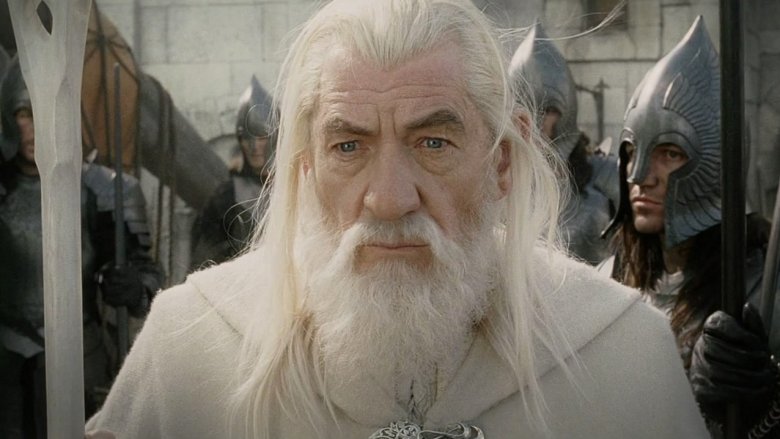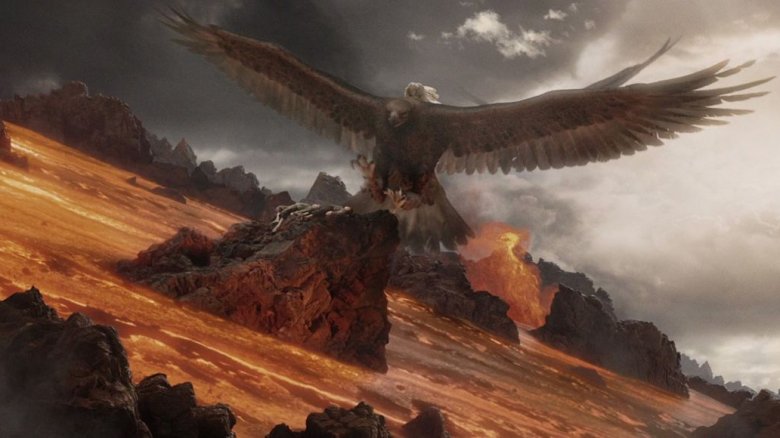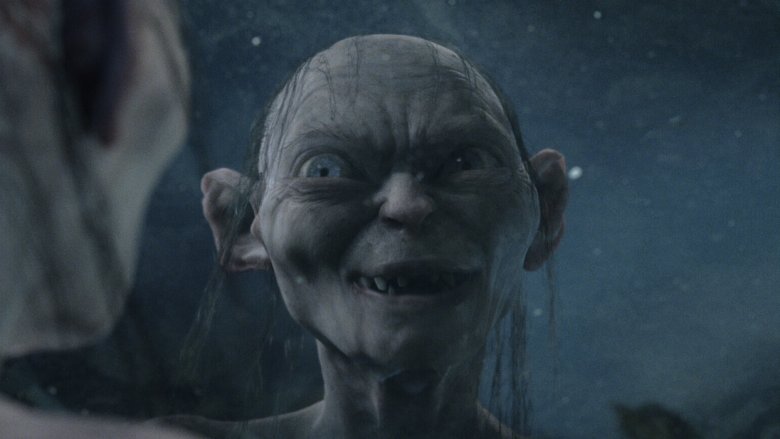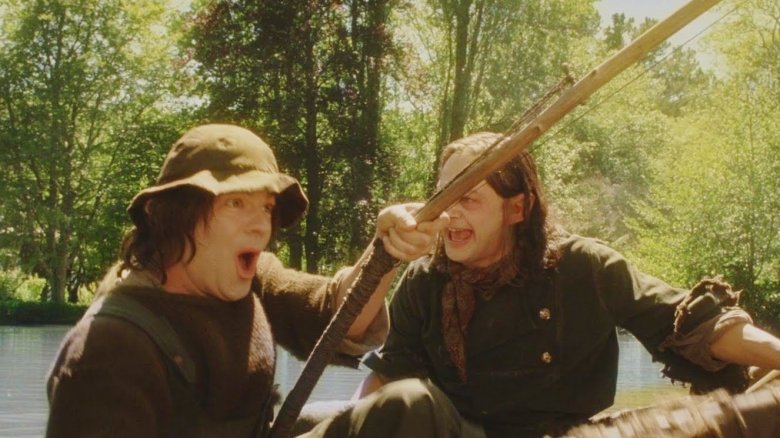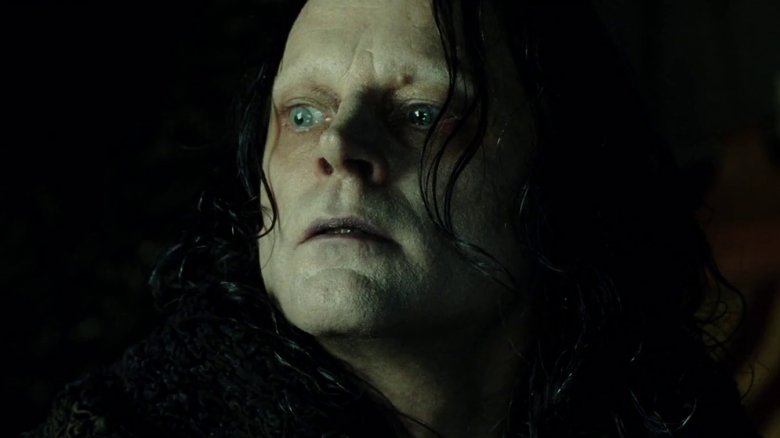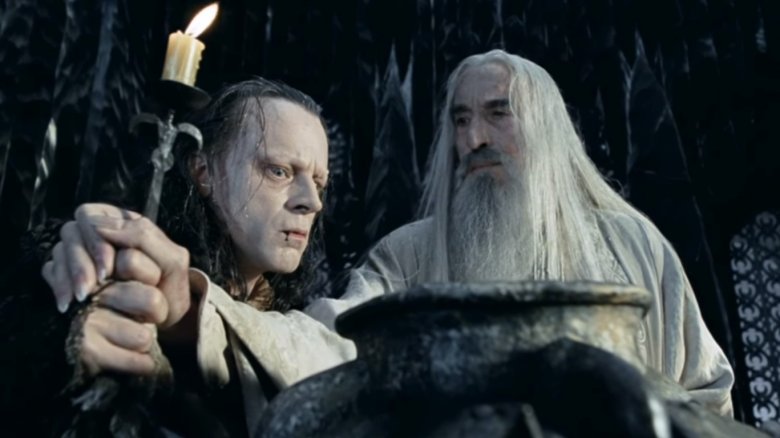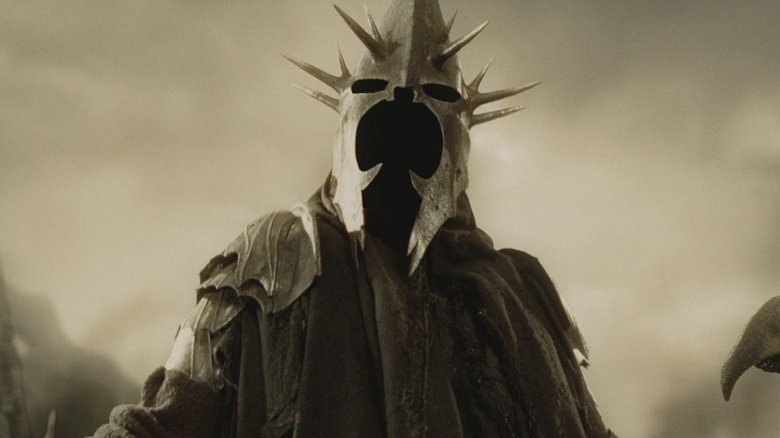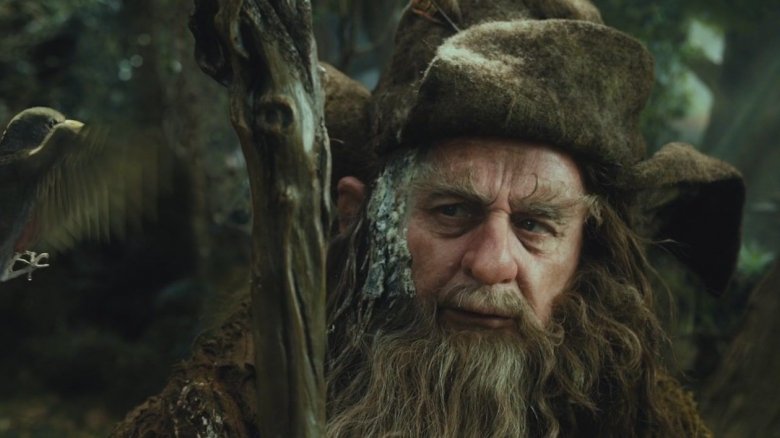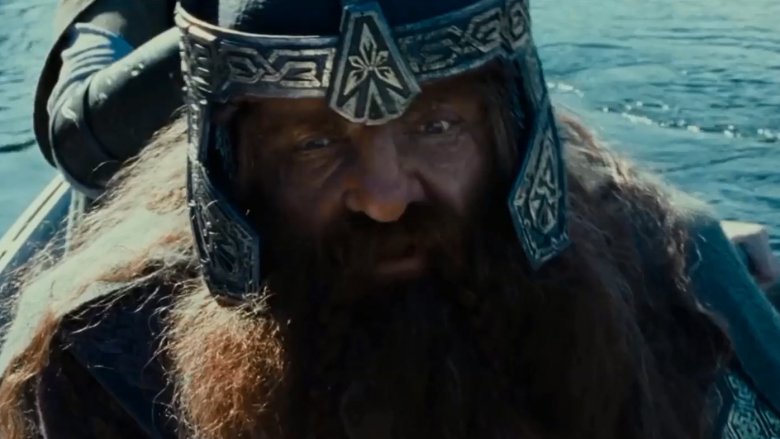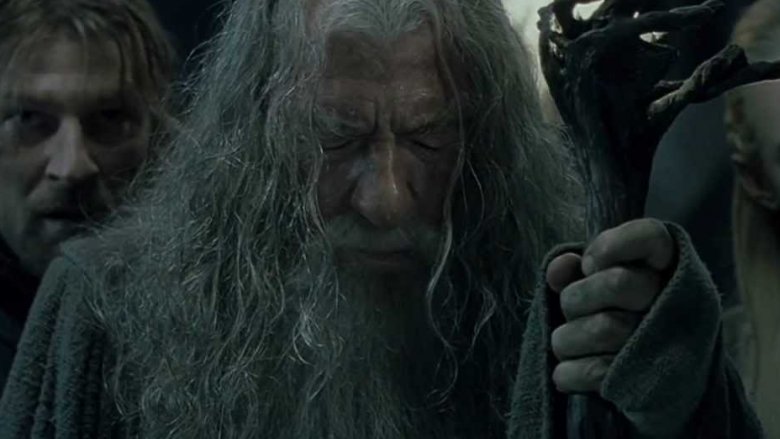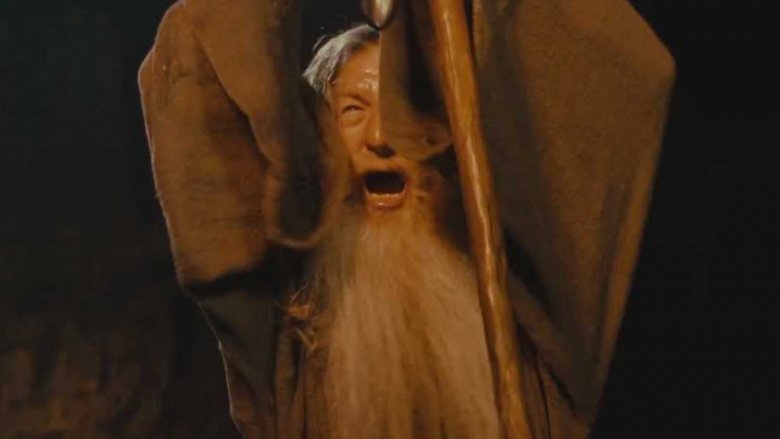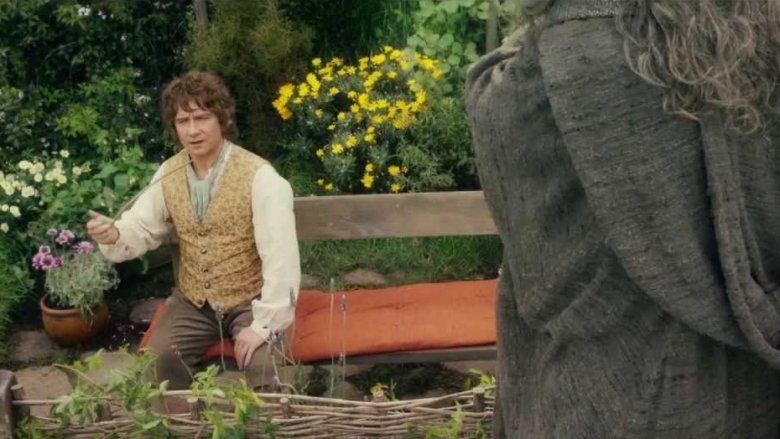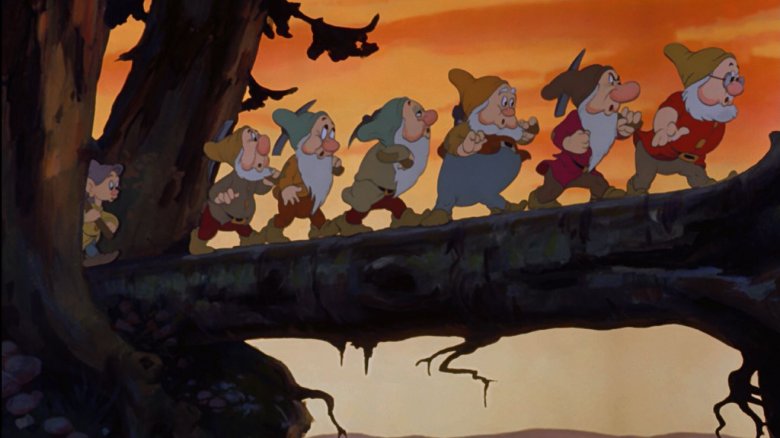Lord Of The Rings Theories That Would Change Everything
J.R.R. Tolkien was a thoughtful fellow. He spent years creating and developing his mythical world of Middle-earth, filling every crack in the story and leaving no stone unturned. And yet, even a lifetime of careful attention can't stop rampant speculation. The internet, in particular, has spawned a host of fan theories, precipitated by The Lord of the Rings films and The Hobbit trilogy, which launched the already popular Middle-earth mythos into the limelight over the last two decades.
Some of these theories simply attempt to connect the dots or offer explanations for the unexplained. Others boldly go out on a limb and make assumptions that probably would make the creator himself turn in his grave.
With Tolkien's world continuing to gain momentum — particularly in the form of Amazon's gargantuan LOTR series — it's a near certainty that these theories will only continue to multiply. So we've decided to gather the best of the bunch so far. These hypotheses suggest scenarios and ideas that aren't just interesting, unsettling, or shocking. If proved true, these Lord of the Rings theories would change everything about the history of Middle-earth itself.
Using eagles to destroy the ring was the plan all along
Everyone and their mother knows about the "why didn't they just use the eagles to fly to Mount Doom and destroy the ring?" argument. It's a fair question to ask, and there are plenty of answers for and against it. But one fan theory, in particular, manages to bring all of them together into an impressively believable explanation: The eagles were the plan all along.
The theory suggests that after being saved by the eagles from his imprisonment on the top of Orthanc, Gandalf decides that this winged transportation is, indeed, the best way to try to catch Sauron by surprise and destroy the ring. He keeps his plan secret, avoiding the northern pass through the Misty Mountains so as not to arouse suspicion from Saruman's spies.
The best part is, the theory suggests that when he falls in combat with the Balrog and shouts his iconic line — "Fly, you fools!" — he's not just telling his companions to get out of Moria, he's trying to communicate his plan with the eagles. Of course, this doesn't work, and by the time he returns as Gandalf the White, he's forgotten much ... including his plan.
The theory is an intriguing one. If Gandalf hadn't fallen in the second half of The Fellowship of the Ring, the heroes could've simply headed north from Moria and nabbed a quick flight over the Mountains of Shadow. The end.
The strange theory about Gollum's split personality
Smeagol is one of the most pitiably lovable characters from The Lord of the Rings. Anyone with a heart can feel for the guy as he struggles with a centuries-old obsession with a power far too big for his own good. And then there's Gollum, the other side of his "split personality." Gollum represents all of the bad stuff. He hates everyone, is a murderer, and will do anything to get his "precious."
While most people generally take the two halves of the character as a sort of interesting case of a multiple personality disorder, one fan theory suggests a different take. Rather than explaining Gollum as the bad side of the hobbit-like creature, the theory goes right out on a limb and claims that "Gollum" is a legitimate personality all its own that resides within the One Ring itself.
The theory points out that when Bilbo has the ring, he acts very similarly to the Gollum personality. Frodo acts a bit like that, as well. In short, anyone tempted by the ring — not just Smeagol — can exhibit snippets of this domineering identity, and if conquered by it, they would be completely consumed by the Gollum personality, which makes one wonder what would've happened to Bilbo if he'd never given it up after his party.
Who killed Frodo's parents?
In the beginning of The Fellowship of the Ring, we find out that Frodo's parents drowned in a boating incident. While it was officially accidental, dark rumors also swirled after the fact that his mother actually tried to push his father in, and he pulled her in with him. Accident or not, that was the story as far as everyone knew it ... until now.
According to one interesting theory on Reddit, the story of the accident/murder is actually a misdirect. Instead, the theory proposes that it was none other than Gollum himself who killed his future master's parents as they coasted along the water after dinner in the moonlight. While the theorist admits that the coincidence would've been unlikely, they make some solid points about why it still could've happened.
For one thing, Gollum is looking for "Shire" and "Baggins" around that time. Frodo's father was Drogo Baggins, and who's to say the vengeful creature didn't simply bump off the first Baggins he ran across? Not finding the ring on the body, Gollum would've headed south, drawn towards the One Ring's master. While it takes a little explaining, it does make one wonder what would've happened if Frodo, the one who shows Smeagol mercy multiple times, had ever found out that Gollum was the one that murdered his parents.
The not-so-crazy cannibal theory
This one is actually a twofer. Let's start with the theory that's quite possibly true: Tolkien included cannibalism in his trilogy. No, we're not talking about orcs eating man flesh. We're talking about Grima Wormtongue eating hobbit flesh. At the end of The Return of the King novel, Saruman taunts Wormtongue for killing Frodo's corrupt relative Lotho. The wizard states that, "Worm killed your Chief ... Stabbed him in his sleep, I believe. Buried, him, I hope; though Worm has been very hungry lately."
And it's that last little zinger that has led many to question if Wormtongue actually straight-up ate the body in his extreme hunger. If he did, it would go a long way in explaining what pushed the wretched fellow to finally snap and kill his master.
Cannibalism aside, another theory suggests the idea that Saruman's horrible treatment of Wormtongue wasn't just turning him into a pale wretch of a man, it was actually transforming him into an orc. In other words, after creating the orc hybrid of the Uruk-hai earlier in the story, perhaps Saruman was actually experimenting with warping a person into an entirely new breed of orcs. It's a chilling thought that could've had drastic repercussions if Wormtongue hadn't been killed before the transition could fully take place.
Grima, the Ringworm
LOTR theorists love coming up with stories about Grima Wormtongue, and this one has to do with rings of power ... but not the rings that we're used to though. This time we're talking about totally new, hypothetical rings made by Saruman himself. The theory points out that Saruman emulated the Dark Lord in most of the things that he did. So why not make rings of his own, too?
There are multiple instances in the trilogy where it's vaguely mentioned that Saruman has an interest in rings. When Gandalf tells the story of his captivity at the Council of Elrond, for instance, he specifically points out that he'd noticed that Saruman was wearing a ring. On top of that, when Saruman announces his treachery to Gandalf, he refers to himself as "Saruman Ring-maker."
If we can assume from these hints that Saruman was busy making his own power-infused rings, then why would he stop at making one for himself? Wouldn't he want to copy Sauron and make other rings to use as a tool for the domination of others, the same way Sauron took control of the Black Riders? The theory suggests that none other than Grima Wormtongue is the possessor of a Saruman ring, forcing him to serve his wizardly master and making him "Grima, the Ringworm." If that were the case, it's a good thing that Gandalf and company managed to shut the traitor down before his plans got out of hand.
Tom Bombadil is the Witch King
Fans of the LOTR books are familiar with the jolly character of Tom Bombadil. The "enigma" (to use Tolkien's own words in a letter to a fan in 1954) is a subtly powerful being that lives out in the Old Forest. He also has no interest in the affairs of the world ... or so he claims. One clever theorist, though, has taken to the internet with a long, drawn-out, and thoroughly crazy accusation that Tom Bombadil is none other than the Witch King himself.
Now, before you laugh and move on, it's worth hearing a few of the major points of the theory. For instance, when the hobbits runs into the merry old fellow in The Fellowship of the Ring, it's pointed out that he has a glint in his eye when the Black Riders are mentioned. And then there's the fact that he can see Frodo clearly when the hobbit is wearing the One Ring, just like the Witch King at Weathertop. And when Tom puts the magical piece of jewelry on his own finger? It has no effect on him, much in the same way that it wouldn't have an effect on a true servant of Sauron, either.
If by some crazy happenstance this theory were true, though, it would mean Frodo was literally hosted by the Witch King for a chunk of time, which is a pretty hard pill to swallow, all things considered.
Does Radagast show up in The Lord of the Rings: The Two Towers?
In the beginning of The Two Towers, Aragorn, Legolas, and Gimli chase a troop of orcs and Uruk-hai that have captured their hobbit friends, Merry and Pippin. But eventually, they discover their enemies have been destroyed, and the hobbits are missing. As they prepare to head into the forest of Fangorn to search for them, they run into an interesting character — in the book, at least. As they sit, resting by a fire in the dark, suddenly they see "an old bent man, leaning on a staff, and wrapped in a great cloak, with his wide-brimmed hat ... pulled down over his eyes."
Before the trio can react, the man disappears without a trace. When they meet Gandalf shortly afterward, he clarifies that it wasn't him, and so it must've been Saruman. However, one theory suggests that it was none other than Radagast the Brown. The giveaway? There's little to no proof anywhere that Saruman ever wears a hat. The Brown Wizard, on the other hand, does.
Radagast plays a significant part in The Hobbit trilogy and makes a brief appearance in The Fellowship of the Ring book. However, if this theory is true, it would indicate that he was also quite a bit more active during the War of the Ring than anyone might've guessed.
A theory about Gimli's mighty gift
It's strange to think of three hairs as a gift. But in The Fellowship of the Ring, that's all Gimli asks for when Galadriel asks what gift she can give him. On the surface, this present is cute, albeit a little odd. But upon further investigation, it turns out that the elven queen actually has some pretty incredible locks, and Gimli isn't the first person to want in on the golden tresses.
Way back in the First Age, the elf lord Feanor, inspired by the beauty of her radiant hair, requested a strand from Galadriel three times, only to be denied. (Don't worry, though, he was a jerk.) The point is, for her to say yes to Gimli is a really big deal. Especially since he's a dwarf, and everyone knows how well dwarves and elves get along in Middle-earth.
All of this has inspired a theory that the three hairs are actually the great opening gesture in an act of diplomacy, peace, and reconciliation between the two races. The fact that Galadriel, seeing Gimli's pure heart, decides that he's more worthy of a gift like that than one of the greatest elf lords who's ever lived is pretty huge. If this is true, and Gimli eventually managed to set the three golden hairs in imperishable crystal, as he claimed, it may have ultimately precipitated a lasting peace between elves and dwarves. Hey, one can hope anyway, right?
The Lord of the Rings theory about Gandalf's true identity
Okay, we're going to get a little deep for a minute here. See, Tolkien's mythos is loaded with all sorts of fantastic creatures. At the top of the heap is Erú Ilúvatar, who's commonly known as the One. Ilúvatar is essentially the monotheistic creator of Middle-earth, and he orchestrates everything that happens throughout history. However, much of that is done through his servants, the Maiar and the Valar. While many of these angelic creatures feature throughout Tolkien's stories, a handful of the Maiar are particularly popular: the five wizards.
Handpicked ambassadors, the wizards are Maiar sent to help the free peoples of Middle-earth defeat Sauron. Sounds good, right? But one theorist has taken the angelic aspect of one particular wizard to another level. The theory references Gandalf's claim on the Bridge of Khazad-dûm, where he tells the Balrog that he is a "servant of the Secret Fire." If that fire were the "Flame Imperishable" referenced in The Silmarillion, then it would be a power that is only and always with Ilúvatar. Of course, he could simply be what he said: a servant of that flame. But if the theory were actually true, it would completely turn the role of Gandalf the Grey on its head, elevating him from a fairly powerful spiritual being to the top dog in all of the universe.
Gandalf isn't even a wizard?
Everybody knows that Gandalf is a wizard, right? Well, some fans aren't so sure. Oh, sure, he looks like a wizard, with the pointed hat, carved staff, and epic beard. But are we really looking at a bona fide wizard? Or more of a tricksy, lower-level magic-user?
One fan, who clearly enjoys a good RPG, broke down the argument, claiming that while Gandalf is certainly an incredibly skilled and extremely intelligent fighter, his actual wizarding skills are only sub-par. They point out that while Gandalf can mess up pretty much any foe he comes into close contact with, Saruman manages to mop the floor with the "wizard" when actual magic comes into play. He also points out that he defends Minas Tirith with his sword, not spells, even in the direst of circumstances. And the Balrog? Gandalf doesn't blast him to bits with an enchantment. Not even one little spell. Instead, he lures him onto the bridge and breaks it under the weight of the monster.
If the theory were correct, it would spell out one of the greatest hoodwinks in Middle-earth history. Warrior Gandalf convinces all of the free peoples of Middle-earth to follow his lead and listen to his ancient, wizardly wisdom, only to bail everyone out with some hard knocks and heroics when the rubber hits the road.
The Hobbit trilogy is exaggerated on purpose
The Hobbit trilogy was fun. It was exciting. It was colorful. But let's be honest. It was also a bit of a train wreck. In the words of Bilbo himself in the fading moments of The Desolation of Smaug, "What have we done?" But for all of the over-stuffed storylines, extremely long battles, and ridiculously overused CGI, one brilliant theorist has posted an explanation that fixes the entire fiasco with a clever twist: It's all a tall tale from Bilbo's perspective.
See, over the course of his life, Bilbo develops a bit of a habit for embellishing his stories. We can see a sample of it when he's entertaining youngsters with tales of trolls turning to stone at his birthday party in The Fellowship of the Ring. And at the Council of Elrond, when asked to tell his story, he has to start with the caveat that it's the true story, saying, "If some have heard me tell it otherwise ... I ask them to forget it and forgive me."
In short, Bilbo loved to exaggerate his stories, and The Hobbit films are nothing more than Tolkien's classic novel from Mr. Baggins' own perspective. Talk about the best cop out in history.
Is Snow White a sequel to The Lord of the Rings?
One extensive hypothesis laid out by Andres Diplotti over on Cracked makes the incredibly compelling argument that The Lord of the Rings actually has a sequel: Snow White and the Seven Dwarves. We see your eyes rolling there, but this one is pretty thorough. Diplotti masterfully points out an entire string of connections between the two fantasy tales.
For instance, the seven dwarves interestingly coincide with the seven dwarven rings of power, and many of their names literally line up one for one with the Norse translation of Tolkien's dwarves. On top of that, Diplotti draws connections between the geography of the two tales, compares the mirror on the wall to both the Mirror of Galadriel and the eye of Sauron, and posits that the fairy tale prince is Gandalf himself, returned to check in on Sauron's behavior. The love at first sight element in the film also echoes both the Beren and Luthien and Aragorn and Arwen stories, too.
Whatever way you slice it, the guy makes a pretty good point. If the theory were true, that would make Snow White the coda for Middle-earth, and of course, that would mean Disney owns a little chunk of Tolkien's world, because the House of Mouse needs to have a little piece of everything these days, don't they?
